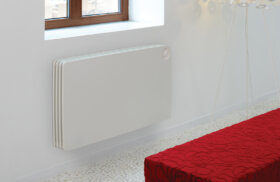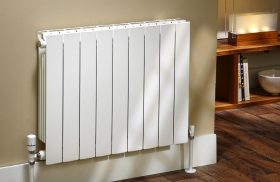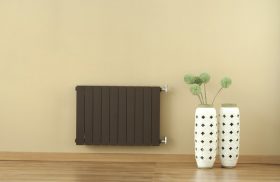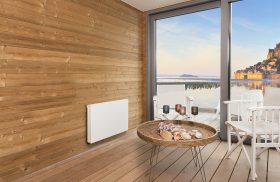Looking to keep a smaller room in the house warm? Corner radiators are becoming a popular option for those wanting to make the most of their space while maintaining its aesthetic appeal.
All of our modern radiators, even for small rooms, are extremely efficient and cost-effective to run, and you won’t have to compromise on style – there are corner radiators which your family and friends may even mistake for stylish décor!
Types of Space-Saving Radiators
Both vertical and horizontal radiators are effective as space-saving radiators for a corner or wall space, however, they do possess differences such as heat efficiency.
Vertical Upright Radiators are perfect for fitting into a corner of a room because, as the description suggests, they are tall, and many are available in a narrower version.
A vertical radiator is a stylish way of heating up your room without compromising on wall space or floor space as it can be mounted. This is super important in areas with limited space such as kitchens, bathrooms and hallways.
Vertical radiators offer the opportunity to be more stylistic than horizontal models because they are upright and can fit seamlessly into your home. The Aluminium Column Radiator is a great choice if you’re looking for a slim design and a high heat space saver.
Standard Horizontal Radiators are the orientation that is more common and the majority of radiators are installed this way. While previously the best place to put your radiator was beneath a window, home insulation is now extremely effective, enabling you to install it wherever you’d like.
There are many attractive horizontal radiators that come in various sizes to suit a smaller space. Your radiator should be located in the coldest area of the room, however, if you’re short on space, you can install it behind a door or in a corner.
Since radiators move heat around a room, this shouldn’t impact its ability to keep the room warm.
Choosing the Right Size and Output
If you’d like to know which radiator model will produce the best heat for your room, use our Heat Output Calculator for a rough estimate.
Simply fill in your room details – floor level, room height and floor space in metres – and we’ll let you know how many watts your room requires.
You can also visit one of our radiator showrooms to talk to our radiator experts about which radiator would fit perfectly in the corners of your room.
If saving space is your goal, there are a few other factors to consider when choosing the right size corner radiator for your room:
- Room size – a smaller room will require a small radiator and might need to be fitted to a specific size corner. Measure the length, width and height of the room in metres and then multiply these values to get the cubic volume of the room.
- Heat output – the heat output of a radiator is measured in British Thermal Units (BTUs) per hour. The heat output required for a room depends on its size, number of windows, insulation and the room’s orientation.
- Type of radiator – different types of radiators have different heat outputs. For instance, a vertical radiator tends to have a higher output than horizontal ones.
- Location – the location of a radiator can affect its performance; if it’s located under a window or in a draughty area, it may require a higher heat output to compensate for the heat loss.
- Style – corner radiators have various styles such as a column radiator or designer radiators.
Installation Considerations
The installation process will depend on the type of radiator you have chosen but it’s important to hire a professional installer to ensure it’s fitted correctly and safety measures are taken. Our radiators need to be installed by a competent plumber or heating engineer. Electric radiators should be installed by a qualified electrician. The general steps that should be taken include:
- Turn off the central heating system
- Drain the system
- Install brackets
- Attach valves
- Connect pipes
- Hang the radiator
- Refill the system
- Bleed the radiator (use a radiator key to bleed any air from the radiator)
- Test the radiator
Radiator Maintenance and Cleaning
Maintaining and cleaning your radiator is important to ensure optimal performance and longevity. Here are some tips to help you maintain and clean your radiator:
- Regular cleaning: Use a soft cloth or a vacuum cleaner to remove any dust or debris from the radiator’s surface.
- Bleeding the radiator: Bleeding your radiator is a process of removing any trapped air in the system. Air can prevent the radiator from heating up effectively, which reduces its performance. Bleeding your radiator once or twice a year can help to maintain its efficiency.
- Checking for leaks: If you notice any leaks, call a professional plumber to repair them as soon as possible.
- Insulating pipes: Insulating the pipes that connect your radiator to the central heating system can help to prevent heat loss, improve efficiency and reduce the risk of them freezing in colder weather.
- Using an inhibitor: Adding an inhibitor to your heating system can help to prevent the build-up of sludge and corrosion in the system, extending its lifespan.
In order to avoid cluttering small spaces, consider purchasing a corner radiator that’s wall mounted, stylish and has an impressive heat output.
We have designer radiators for any corner in your home. Visit one of our radiator showrooms to browse your ideal shape, size, and style and talk to our experts about the best space-saving radiators.





